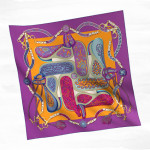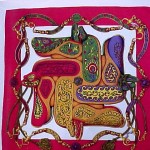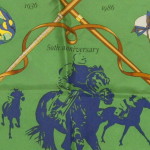28 May
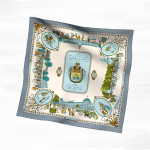
Design by Philippe Ledoux
Year: 1962, 1970s, 2014 (as 70cm)
No. 1350
Centred on the heraldic arms of the City of Paris, a charming mise en scène captures images of everyday life in the French capital during the First Empire: promenades, bygone trades and children at play. Soldiers and onlookers throng the kiosks, fashionable cafés and restaurants of the Palais Royal. The Tuileries Gardens attract children bowling hoops, hot chestnut-sellers and miniature carriages drawn by goats. The Champs-Elysées is the promenade of choice for elegant carriages, riders and society ladies taking the route to the country, and the racecource at Longchamp. At the Invalides – founded by Louis XIV as a home for wounded servicemen, and the last resting-place of the Emperor Napoleon – the vast esplanade offers a backdrop for military parades and peaceable strolls. Paris is a playground, too: skittles, badminton, and games of skipping and cup-and-ball were favourite pastimes for children in the early nineteenth century.
Old copyright:
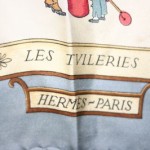
08 May
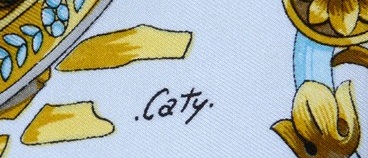
Also known as Cathy Latham-Audibert. Her output at Hermes covers over 45 incredible years. Best known for designing Cles (one of the Top 10 best-selling Hermes scarves of all time) and her self-referential designs.
Her first two designs have no signature (Cles and Vendanges). Afterwards, she signed her designs as “.Caty.” for a decade before switching to signing as “Latham.”
- 1965 Les Cles
- 1965 /1966 Vendanges
- 1967 Les Roues
- 1968 Fronteaux et Cocardes
- 1970 Egypte
- 1970 Ferronnerie
- 1970 Aux Champs
- 1971 Tahiti
- 1971 Feux de Route
- 1972 Brandenbourgs (No. 1569)
- 1973 Maillons
- 1973 Pyramids
- 1975 Opera Palais Garnier
- 1975 Epaulettes
- Harald
- 1977 Oiseaux Migrateurs
- 1978 Gaucho
- 1978 Washington’s Carriage
- 1979 Sulfures & Presse-Papiers
- 1982 Fleurs de Montagne
- 1982 Haute Montagne
- 1983 Sequences
- 1983 Anemones
- 1985 Mexique
- 1985 Farandole
- 1986 India
- 1986 Petite Main
- 1988 Flies
- 1989 Neige d’Antan
- 1990 Correspondance
- 1991 Reveries Japonaises
- 1992 Memoire d’Hermes
- 1992 Haute Montagne
- 1993 Emblemes de l’Europe
- 1994 Couvees Hermes
- 1994 Les Oiseaux du Roy
- 1995 Soleil de Soie
- 1996 Confort en Automobile
- 1997 Cuillers d’Afrique
- 1998 Copeaux
- 1999 Tibet
- 2000 Doigts de Fee
- 2001 Neige d’Antan (Detail)
- 2002 Tout Cuir
- 2002 Tibet II (Detail)
- 2002 Sulfures & Presse-Papiers II (Detail)
- Les Baudriers
- 2005 Porte Bonheur
- 2007 Carnets de Bal
- 2007 Bolduc au Carre
- 2008 Tout en Quilt
- 2011 Pois de Soie
- Rythmes
- Le Salon Dore
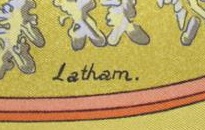
08 May

Design by Pierre Marie
New 70cm design in Sp 2014, twilly in Sp 2014
No. 2812
The sirens of legend were women whose melodious singing bewitched mariners, drawing them down into the depths of the ocean. George Sidney’s Le Bal des sirènes (Bathing beauty, 1944) – a love story between a ravishing girl swimmer and a musician – is a far cheerier tale. The film made its star, Esther Williams, famous. Backed by a troupe of sparkling fellow athletes, their acrobatic formations and choreographed swimming were admired by generations. Synchronised swimming – a mix of swimming, dance and gymnastics – had made its first appearance a few decades earlier, but its popularity soared thanks to Esther Williams’s musicals. This scarf is an alluring group portrait, presenting the remarkable young women whose grace and dazzling smiles bely their extraordinary physical strength and prowess.
07 May
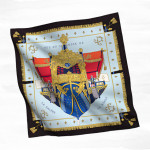
Artist: Hugo Grygkar
Year: 1953, 1970s, 1980s, 1992, 2007, Sp 2014
No. 1191
Subject: View of ship’s hull from the deck of Louis XIV’s ship La Reale (The Royal)
Note: often referred to by the letters on the carre “Vue de Carrosse”
Hermes.com: Among the major works on show at the Musée Nationale de la Marine, in Paris, is this sumptuous, carved transom stern dating from the 17th century. The ship in question is the Réale, from the royal fleet of Louis XIV. This remarkable warship, noted for its elegant lines and rich ornamental carvings, was sailed by an exceptionally large crew. Reserved for the admiral of the fleet, she sailed until the beginning of the 18th century. Her carvings – the source of Hugo Grygkar’s inspiration – featured sea gods blowing into conch shells (near the water line), figures of Fame blowing their trumpets to the glory of the King, and other reliefs. They are generally thought to be the work of Pierre Puget, a renowned French artist from the city of Marseille, who spent several years in Florence, and later Rome, learning and perfecting the art of sculpture. In the 19th century, his forceful style earned him the title ‘the French Michelangelo’.
References: Diane Keaton wearing Colorway #37 in Mad Money (2007)
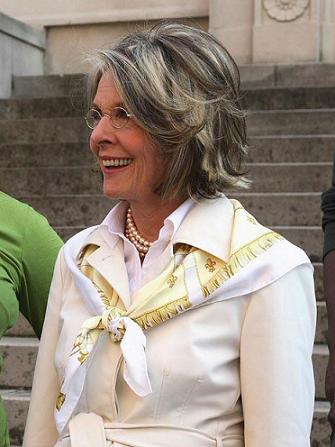


 Posted in
Posted in 
